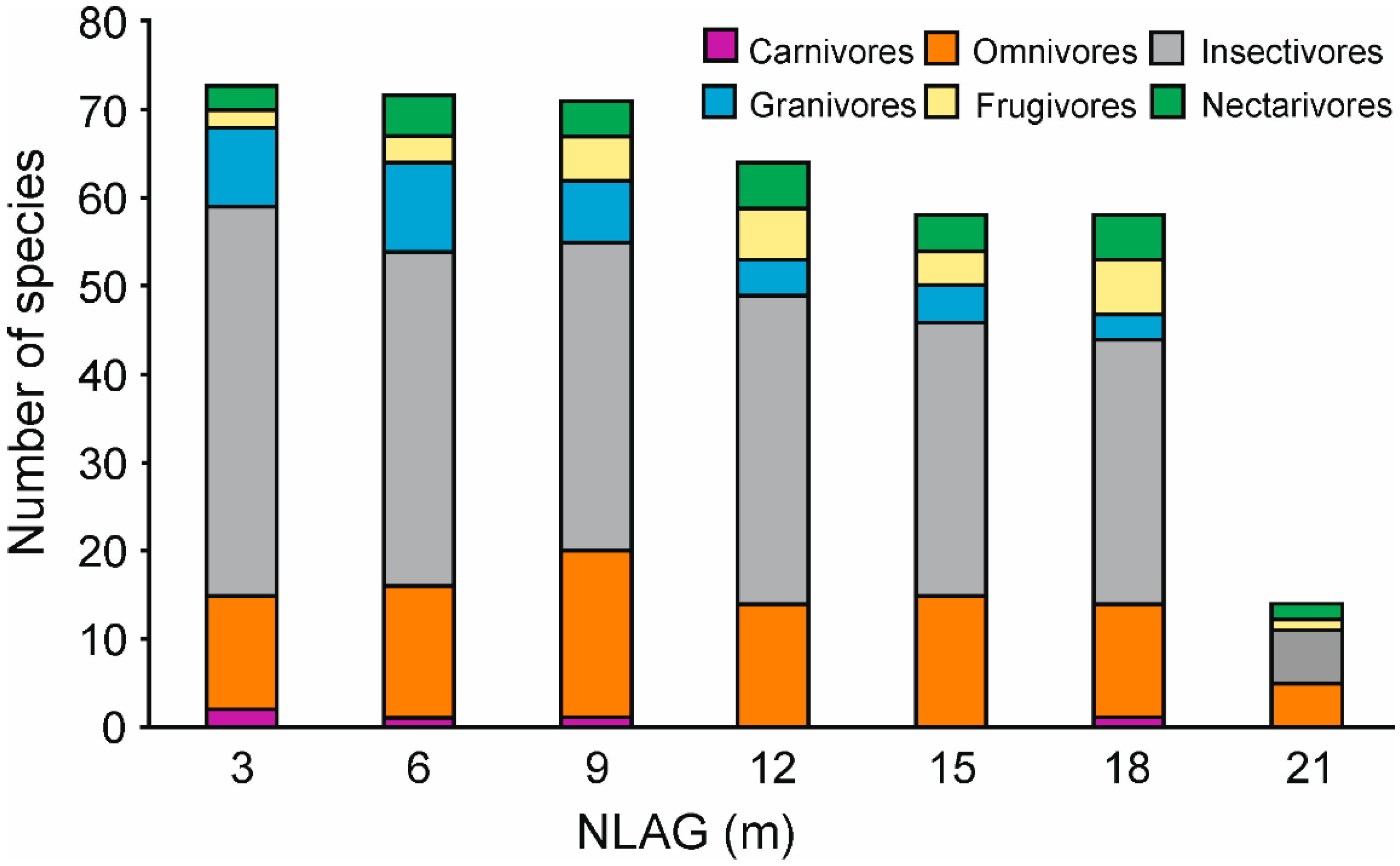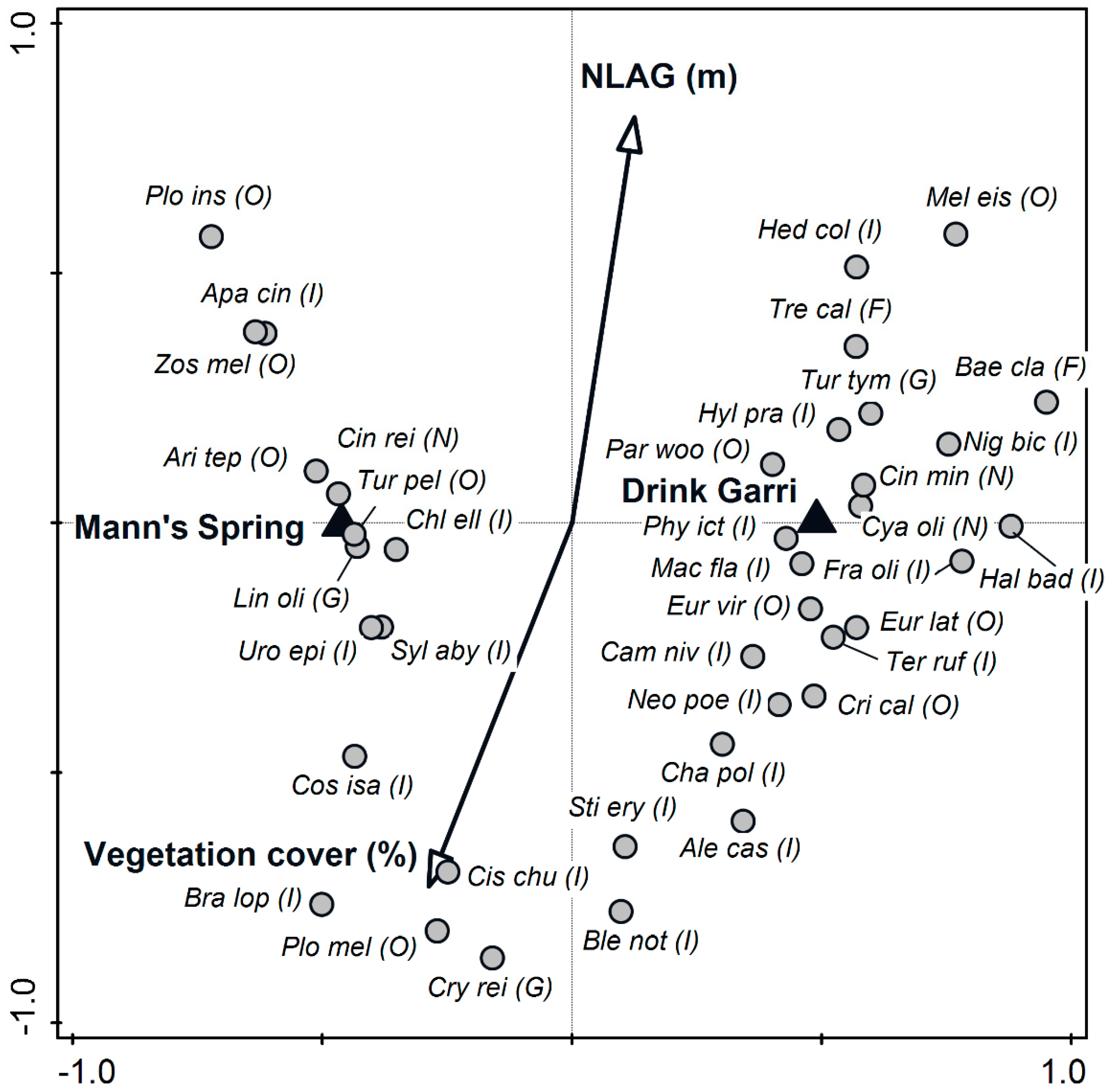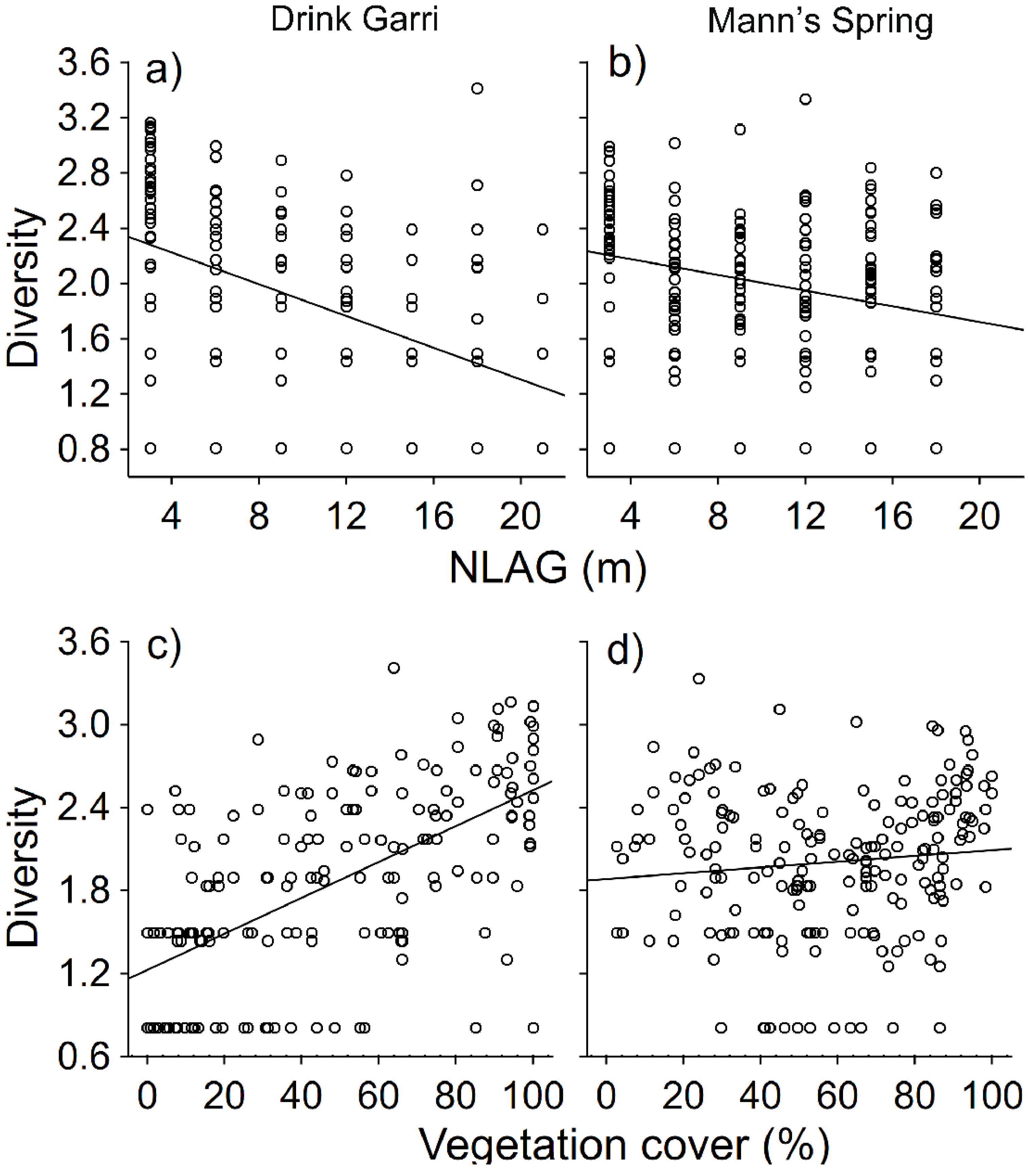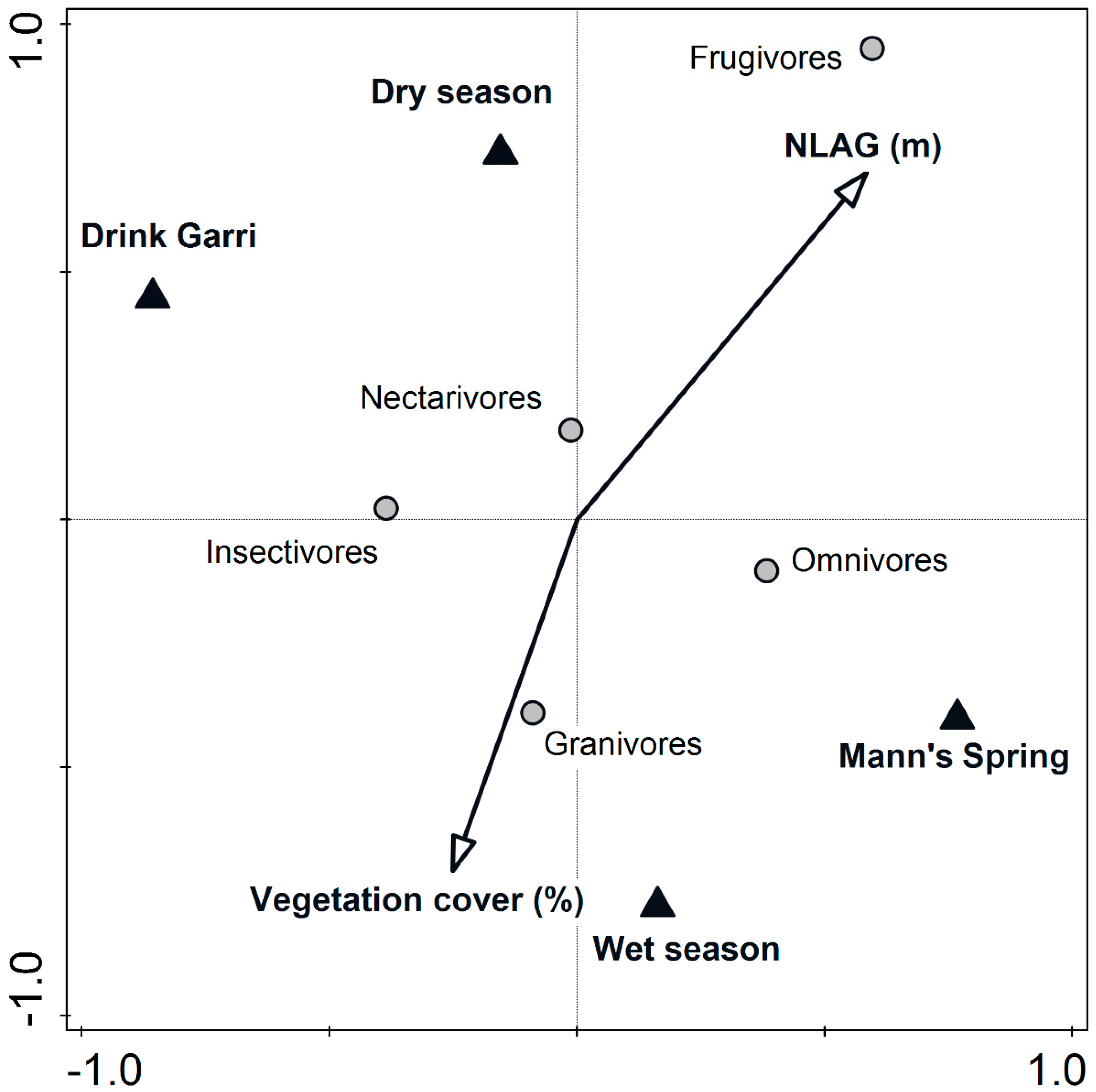Changes in Bird Community Structure on Mount Cameroon Driven by Elevational and Vertical Gradients
Abstract
1. Introduction
2. Materials and Methods
2.1. Study Area
2.2. Bird Data Collection
2.3. Statistical Analyses
3. Results
4. Discussion
5. Conclusions
Supplementary Materials
Author Contributions
Funding
Institutional Review Board Statement
Data Availability Statement
Acknowledgments
Conflicts of Interest
References
- Tamungang, S.A.; Cheke, R.A.; Mofor, G.Z.; Tamungang, R.N.; Oben, F.R. Conservation Concern for the Deteriorating Geographical Range of the Grey Parrot in Cameroon. Int. J. Ecol. 2014, 15, 753294. [Google Scholar] [CrossRef][Green Version]
- Tamungang, S.A.; Onabid, M.A.; Awa, T.; Balinga, V.S. Habitat preferences of the grey parrot in heterogeneous vegetation landscapes and their conservation implications. Int. J. Biodivers. 2016, 2016, 7287563. [Google Scholar] [CrossRef][Green Version]
- Myers, N.; Mittermeier, R.A.; Mittermeier, C.G.; da Fonseca, G.A.B.; Kent, J. Biodiversity hotspots for conservation priorities. Nature 2000, 403, 853–858. [Google Scholar] [CrossRef] [PubMed]
- Quintero, I.; Jetz, W. Global elevational diversity and diversification of birds. Nature 2018, 555, 246–250. [Google Scholar] [CrossRef]
- Castley, J.G.; Kerley, G.I.H. The paradox of forest conservation in South Africa. For. Ecol. Manag. 1996, 85, 35–46. [Google Scholar] [CrossRef]
- Hemp, A. Continuum or zonation? Altitudinal gradients in the forest vegetation of Mt. Kilimanjaro. Plant Ecol. 2005, 184, 27–42. [Google Scholar] [CrossRef]
- Mucina, L.; Geldenhuys, C.J. Afrotemperate, subtropical and azonal forests. In The Vegetation of South Africa, Lesotho and Swaziland; Strelitzia 19; Mucina, L., Rutherford, M.C., Eds.; South African National Biodiversity Institute: Pretoria, South Africa, 2006; pp. 585–614. [Google Scholar]
- MacArthur, R.H.; MacArthur, J.W. On bird species diversity. Ecology 1961, 42, 594–598. [Google Scholar] [CrossRef]
- Acharya, B.K.; Vijayan, L. Vertical stratification of birds in different vegetation types along an elevation gradient in the Eastern Himalaya, India. Ornithol. Sci. 2017, 16, 131–140. [Google Scholar] [CrossRef]
- Diaz, I.A.; Armesto, J.J.; Reid, S.; Sieving, K.E.; Willson, M.F. Linking forest structure and composition: Avian diversity in successional forests of Chiloé Island, Chile. Biol. Conserv. 2005, 123, 91–101. [Google Scholar] [CrossRef]
- Winkler, H.; Preleuthner, M. Behaviour and ecology of birds in tropical rain forest canopies. Plant Ecol. 2001, 153, 193–202. [Google Scholar] [CrossRef]
- Turner, I.M. Species loss in fragments of tropical rain forest: A review of the evidence. J. Appl. Ecol. 1996, 33, 200–209. [Google Scholar] [CrossRef]
- Rahbek, C. The role of spatial scale and the perception of large-scale species-richness patterns. Ecol. Lett. 2005, 8, 224–239. [Google Scholar] [CrossRef]
- Lee, P.Y.; Rotenberry, J.T. Relationships between bird species and tree species assemblages in forested habitats of eastern North America. J. Biogeogr. 2005, 32, 1139–1150. [Google Scholar] [CrossRef]
- Wiens, J.A. Spatial scaling in ecology. Funct. Ecol. 1989, 3, 385–397. [Google Scholar] [CrossRef]
- Pearson, D.L. Vertical stratification of birds in a tropical dry forest. Condor 1971, 73, 46–55. [Google Scholar] [CrossRef][Green Version]
- Anderson, S.H.; Shugart, H.H.; Smith, T.M. Vertical and Temporal Habitat Utilization within a Breeding Bird Community; Academic Press: New York, NY, USA, 1979; pp. 203–216. [Google Scholar]
- Terborgh, J. Vertical stratification of a Neotropical Forest bird community. In Proceedings of the Acta XVII Congressus Internationalis Ornithologici, Berlin, Germany, 5–11 June 1978; Nöhring, R., Ed.; Deutsche Ornithologen-Gesellschaft: Berlin, Germany, 1980; pp. 1005–1012. [Google Scholar]
- Greenberg, R. The abundance and seasonality of forest canopy birds on Barro Colorado Island, Panama. Biotropica 1981, 13, 241–251. [Google Scholar] [CrossRef]
- Cody, M.L. Habitat Selection in Birds; Academic Press: Cambridge, MA, USA, 1985. [Google Scholar]
- Haffer, J. Vögel Amazoniens: Ökologie, Brutbiologie und Artenreichtum. J. Ornithol. 1988, 129, 1–53. [Google Scholar] [CrossRef]
- Marra, P.P.; Remsen, J.V. Insights into the maintenance of high species diversity in the Neotropics: Habitat selection and foraging behavior in understory birds of tropical and temperate forests. Ornithol. Monogr. 1997, 48, 445–483. [Google Scholar] [CrossRef]
- Chmel, K.; Riegert, J.; Paul, L.; Novotný, V. Vertical stratification of an avian community in New Guinean tropical rainforest. Popul. Ecol. 2016, 58, 535–547. [Google Scholar] [CrossRef]
- Chmel, K.; Kamga, S.M.; Awa, T.; Ewome, F.L.; Uceda-Gómez, G.; Hořák, D.; Janeček, Š. Vertical stratification and seasonal changes of the avian community in Mount Cameroon lowland rainforest. Afr. J. Ecol. 2021, 59, 655–666. [Google Scholar] [CrossRef]
- Grubb, P.J.; Lloyd, J.R.; Pennington, T.D.; Whitmore, T.C. A comparison of montane and lowland rain forest in Ecuador I. The forest structure, physiognomy, and floristics. J. Ecol. 1963, 55, 567–601. [Google Scholar] [CrossRef]
- Jankowski, J.E.; Merkord, C.L.; Rios, W.F.; Cabrera, K.G.; Revilla, N.S.; Silman, M.R. The relationship of tropical bird communities to tree species composition and vegetation structure along an Andean elevational gradient. J. Biogeogr. 2013, 40, 950–962. [Google Scholar] [CrossRef]
- Richards, P.W. The Tropical Rain Forest: An Ecological Study; Cambridge University Press: Cambridge, UK, 1996. [Google Scholar]
- Walther, B.A.; Clayton, D.H.; Gregory, R.D. Showiness of Neotropical birds in relation to ectoparasite abundance and foraging stratum. Oikos 1999, 87, 157–165. [Google Scholar] [CrossRef]
- Patterson, B.D.; Stotz, D.F.; Solari, S.; Fitzpatrick, J.W.; Pacheco, V. Contrasting patterns of elevational zonation for birds and mammals in the Andes of southeastern Peru. J. Biogeogr. 1998, 25, 593–607. [Google Scholar] [CrossRef][Green Version]
- Jankowski, J.E.; Ciecka, A.L.; Meyer, N.Y.; Rabenold, K.N. Beta diversity along environmental gradients: Implications of habitat specialization in tropical montane landscapes. J. Anim. Ecol. 2009, 78, 315–327. [Google Scholar] [CrossRef] [PubMed]
- Fleishmann, E.; Mac Nally, R. Patterns of spatial autocorrelation of assemblages of birds, floristics, physiognomy, and primary productivity in the central Great Basin, USA. Divers. Distrib. 2006, 12, 236–243. [Google Scholar] [CrossRef]
- Jayapal, R.; Qureshi, Q.; Chellam, R. Importance of forest structure versus floristics to composition of avian assemblages in tropical deciduous forests of Central Highlands, India. For. Ecol. Manag. 2009, 257, 2287–2295. [Google Scholar] [CrossRef]
- Leuschner, C. Are high elevations in tropical mountains arid environments for plants? Ecology 2000, 81, 1425–1436. [Google Scholar] [CrossRef]
- Ter Braak, C.J.; Smilauer, P. Canoco Reference Manual and User’s Guide: Software for Ordination, Version 5.0; Microcomputer Power: Ithaca, Greece, 2012. [Google Scholar]
- Marrot, P.; Garant, D.; Charmantier, A. Spatial autocorrelation in fitness affects the estimation of natural selection in the wild. Methods Ecol. Evol. 2015, 6, 1474–1483. [Google Scholar] [CrossRef][Green Version]
- Legendre, P.; Legendre, L. Numerical Ecology, 3rd ed.; Elsevier: Amsterdam, The Netherlands, 2012. [Google Scholar]
- Šmilauer, P.; Lepš, J. Multivariate Analysis of Ecological Data Using CANOCO 5; Cambridge University Press: Cambridge, UK, 2014. [Google Scholar]
- TIBCO Software Inc. Statistica (Data Analysis Software System), Version 13. 2017. Available online: http://statistica.io (accessed on 1 January 2023).
- R Core Team. R: A Language and Environment for Statistical Computing; R Foundation for Statistical Computing: Vienna, Austria, 2020; Available online: https://www.R-project.org/ (accessed on 1 January 2023).
- Terborgh, J. Distribution on environmental gradients: Theory and a preliminary interpretation of distributional patterns in the avifauna of the Cordillera Vilcabamba, Peru. Ecology 1971, 52, 23–40. [Google Scholar] [CrossRef]
- Loiselle, B.A.; Blake, J.G. Temporal variation in birds and fruits along an elevational gradient in Costa Rica. Ecology 1991, 72, 180–193. [Google Scholar] [CrossRef]
- McCain, C.M.; Colwell, R.K. Assessing the threat to montane biodiversity from discordant shifts in temperature and precipitation in a changing climate. Ecol. Lett. 2011, 14, 1236–1245. [Google Scholar] [CrossRef] [PubMed]
- Jankowski, J.E.; Londono, G.A.; Robinson, S.K.; Chappell, M.A. Exploring the role of physiology and biotic interactions in determining elevational ranges of tropical animals. Ecography 2012, 36, 1–12. [Google Scholar] [CrossRef]
- MINFOF. The Management Plan of the Mount Cameroon National Park and Its Peripheral Zone; Action Plan; MINFOF: Bertoua, Cameroun, 2014. [Google Scholar]
- Blake, J.G.; Loiselle, B.A. Diversity of birds along an elevational gradient in the Cordillera Central, Costa Rica. Auk 2000, 117, 663–686. [Google Scholar] [CrossRef]
- Terborgh, J.; Davenport, L.C.; Niangadouma, R.; Dimoto, E.; Mouandza, J.C.; Schultz, O.; Jaen, M.R. The African rainforest: Odd man out or megafaunal landscape? African and Amazonian forests compared. Ecography 2016, 39, 187–193. [Google Scholar] [CrossRef]
- Herzog, S.K.; Kessler, M.; Bach, K. The elevational gradient in Andean bird species richness at the local scale: A foothill peak and a high-elevation plateau. Ecography 2005, 28, 209–222. [Google Scholar] [CrossRef]
- Quitián, M.; Santillán, V.; Espinosa, C.I.; Homeier, J.; Böhning-Gaese, K.; Schleuning, M.; Neuschulz, E.L. Elevation-dependent effects of forest fragmentation on plant–bird interaction networks in the tropical Andes. Ecography 2018, 41, 1497–1506. [Google Scholar] [CrossRef][Green Version]
- Bell, H.L. A bird community of lowland rainforest in New Guinea. I. Composition and density of the avifauna. Emu 1982, 82, 24–41. [Google Scholar] [CrossRef]
- Deshwal, A.; Stephenson, S.L.; Panwar, P.; DeGregorio, B.A.; Kannan, R.; Willson, J.D. Foraging habitat selection of shrubland bird community in tropical dry forest. Ecol. Evol. 2022, 12, e9192. [Google Scholar] [CrossRef]
- Amahowé, I.O.; Djossa, A.B.; Adomou, A.C.; Kabré, A.T.; Sinsin, B. Vegetation structure and tree diversity in habitats exploited by elephants in Benin (West Africa). J. Appl. Biosci. 2012, 58, 4223–4233. [Google Scholar]
- Maicher, V.; Delabye, S.; Murkwe, M.; Doležal, J.; Altman, J.; Kobe, I.N.; Desmist, J.; Fokam, E.B.; Pyrcz, T.; Tropek, R. Effects of disturbances by forest elephants on diversity of trees and insects in tropical rainforests on Mount Cameroon. Sci. Rep. 2020, 10, 21618. [Google Scholar] [CrossRef] [PubMed]
- Carroll, R.W. Relative density, range extension, and conservation potential of the lowland gorilla (Gorilla gorilla gorilla) in the Dzanga-Sangha region of southwestern Central African Republic. Mammalia 1988, 52, 309–324. [Google Scholar] [CrossRef]
- Kamga, S.M.; Tamungang, S.A.; Awa, T.; Ewome, F.L.; Motombi, F.N.; Hořák, D.; Riegert, J. The Importance of Forest Elephants for Vegetation Structure Modification and Its Influence on the Bird Community of a Mid-Elevation Forest on Mount Cameroon, West-Central Africa. Diversity 2022, 14, 227. [Google Scholar] [CrossRef]
- Bradfer-Lawrence, T.; Gardner, N.; Dent, D.H. Canopy bird assemblages are less influenced by habitat age and isolation than understory bird assemblages in Neotropical secondary forest. Ecol. Evol. 2018, 8, 5586–5597. [Google Scholar] [CrossRef] [PubMed]
- Dinanti, R.V.; Winarni, N.L.; Supriatna, J. Vertical stratification of bird community in Cikepuh wildlife reserve, West Java, Indonesia. Biodiversitas 2018, 19, 134–139. [Google Scholar] [CrossRef]
- Sam, K.; Koane, B.; Jeppy, S.; Sykorova, J.; Novotny, V. Diet of land birds along an elevational gradient in Papua New Guinea. Sci. Rep. 2017, 7, 44018. [Google Scholar] [CrossRef][Green Version]
- Schleuning, M.; Blüthgen, N.; Flörchinger, M.; Braun, J.; Schaefer, H.M.; Böhning-Gaese, K. Specialization and interaction strength in a tropical plant–frugivore network differ among forest strata. Ecology 2011, 92, 26–36. [Google Scholar] [CrossRef]
- Janes, S.W. Variation in the species composition and mean body size of an avian foliage gleaning guild along an elevational gradient: Correlation with arthropod body size. Oecologia 1994, 98, 369–378. [Google Scholar] [CrossRef]
- Koen, J.H. Medium-term fluctuations of birds and their potential food resources in the Knysna Forest. Ostrich 1992, 63, 21–30. [Google Scholar] [CrossRef]





| Independent Variable | % of Explained Variability | Pseudo-F | p |
|---|---|---|---|
| Locality | 42.13 | 10.2 | 0.002 |
| NLAG (m) | 11.67 | 2.8 | 0.002 |
| Vegetation cover (%) | 5.97 | 1.4 | 0.002 |
| PCO.5 | 5.16 | 4.7 | 0.002 |
| PCO.53 | 4.06 | 3.7 | 0.002 |
| PCO.41 | 3.78 | 3.5 | 0.002 |
| PCO.40 | 3.58 | 3.3 | 0.002 |
| PCO.24 | 3.14 | 2.9 | 0.002 |
| PCO.16 | 3.07 | 2.9 | 0.002 |
| Independent Variable | Locality | Beta | R2 | F | p |
|---|---|---|---|---|---|
| NLAG | Drink Garri | −0.45 | 0.21 | 46.42 | 0.001 |
| Vegetation cover | Drink Garri | 0.60 | 0.36 | 101.84 | 0.001 |
| NLAG | Mann’s Spring | −0.27 | 0.07 | 14.92 | 0.001 |
| Vegetation cover | Mann’s Spring | 0.10 | 0.01 | 2.09 | 0.149 |
| Independent Variable | % of Explained Variability | Pseudo-F | p |
|---|---|---|---|
| Locality | 63.99 | 27.6 | 0.002 |
| NLAG (m) | 17.68 | 7.8 | 0.002 |
| Vegetation cover (%) | 4.70 | 2.1 | 0.086 |
| Season (dry/wet) | 3.84 | 1.7 | 0.152 |
| PCO.3 | 18.06 | 10.6 | 0.004 |
| PCO.14 | 12.13 | 7.2 | 0.002 |
| PCO.26 | 6.23 | 3.7 | 0.002 |
| PCO.19 | 6.37 | 3.9 | 0.006 |
| Drink Garri | 6 | 9 | 12 | 15 | 18 | 21 |
|---|---|---|---|---|---|---|
| 3 | 0.57 | 0.54 | 0.39 | 0.31 | 0.28 | 0.17 |
| 6 | 0.53 | 0.42 | 0.32 | 0.37 | 0.15 | |
| 9 | 0.46 | 0.46 | 0.45 | 0.22 | ||
| 12 | 0.45 | 0.36 | 0.13 | |||
| 15 | 0.4 | 0.13 | ||||
| 18 | 0.13 | |||||
| Mann’s Spring | 6 | 9 | 12 | 15 | 18 | |
| 3 | 0.62 | 0.64 | 0.51 | 0.5 | 0.47 | |
| 6 | 0.67 | 0.5 | 0.49 | 0.55 | ||
| 9 | 0.79 | 0.63 | 0.58 | |||
| 12 | 0.64 | 0.58 | ||||
| 15 | 0.56 |
Disclaimer/Publisher’s Note: The statements, opinions and data contained in all publications are solely those of the individual author(s) and contributor(s) and not of MDPI and/or the editor(s). MDPI and/or the editor(s) disclaim responsibility for any injury to people or property resulting from any ideas, methods, instructions or products referred to in the content. |
© 2023 by the authors. Licensee MDPI, Basel, Switzerland. This article is an open access article distributed under the terms and conditions of the Creative Commons Attribution (CC BY) license (https://creativecommons.org/licenses/by/4.0/).
Share and Cite
Mekuate Kamga, S.; Tamungang, S.A.; Awa, T., II; Chmel, K.; Luma Ewome, F.; Lyonga Molua, L.; Uceda-Gómez, G.; Janeček, Š.; Mlíkovský, J.; Riegert, J. Changes in Bird Community Structure on Mount Cameroon Driven by Elevational and Vertical Gradients. Diversity 2023, 15, 727. https://doi.org/10.3390/d15060727
Mekuate Kamga S, Tamungang SA, Awa T II, Chmel K, Luma Ewome F, Lyonga Molua L, Uceda-Gómez G, Janeček Š, Mlíkovský J, Riegert J. Changes in Bird Community Structure on Mount Cameroon Driven by Elevational and Vertical Gradients. Diversity. 2023; 15(6):727. https://doi.org/10.3390/d15060727
Chicago/Turabian StyleMekuate Kamga, Solange, Simon A. Tamungang, Taku Awa, II, Kryštof Chmel, Francis Luma Ewome, Lucas Lyonga Molua, Guillermo Uceda-Gómez, Štěpán Janeček, Jiří Mlíkovský, and Jan Riegert. 2023. "Changes in Bird Community Structure on Mount Cameroon Driven by Elevational and Vertical Gradients" Diversity 15, no. 6: 727. https://doi.org/10.3390/d15060727
APA StyleMekuate Kamga, S., Tamungang, S. A., Awa, T., II, Chmel, K., Luma Ewome, F., Lyonga Molua, L., Uceda-Gómez, G., Janeček, Š., Mlíkovský, J., & Riegert, J. (2023). Changes in Bird Community Structure on Mount Cameroon Driven by Elevational and Vertical Gradients. Diversity, 15(6), 727. https://doi.org/10.3390/d15060727







